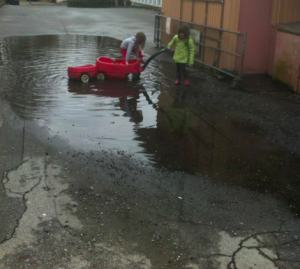
Photo credit: Susan Main
Falling leaves clog drains, then cars hydroplane on huge puddles. Going too fast for the conditions, drivers lose control on black ice. It’s that time of year again.
Vehicle crashes are a leading cause of worker fatalities in our province and beyond, so if you drive for work — or employ people who do — please follow the steps below.
If you have any other tips or resources, please share them with everyone in the comments.
Step 1: Recognize the risk; understand your legal responsibilities
Here in B.C., employers are subject to provincial and federal laws around employees who drive for work. Employers can take a free online course called Winter Driving Safety, created by the Justice Institute of B.C. and WorkSafeBC. It offers employers tools for planning and implementing a winter driving safety program. Also see these free workplace safety resources, as well as this article from Small Business B.C. on how road safety affects your business.
Workers who drive for work are required to follow traffic laws — including distracted driving laws — and to comply with their company’s or organization’s safe driving practices.
Step 2: Assess the need for travel; plan your trip
Do you really need to go? That’s the most important question to ask yourself. If the answer is yes, make sure you check road conditions, which you can do at DriveBC, along with planning your route. Build in extra time to accommodate reduced speeds or sudden changes in weather conditions.
Also check out the 7 Things You Need to Know BEFORE Driving the Coquihalla and High Mountain Passes.
Step 3: Prepare your vehicle (or your fleet)
Preparing your vehicle includes getting a winter maintenance tune-up, putting winter blades on windshield wipers, and installing winter tires. See Shift into Winter for a list of other preparations to make.
“Do I need to chain up?” B.C.’s Ministry of Transportation and Infrastructure (TranBC) says it depends. Tires with the “Mountain/Snowflake” pictograph on the sidewall are a legal requirement on many B.C. highways during the winter driving season
Step 4: Prepare yourself (or your workers)
Before you get into your vehicle, you should be well rested, nourished, and hydrated so you can focus on safety when behind the wheel.
Keep a well-stocked safety kit in each vehicle, including booster cables, a blanket, and a shovel in case you get stuck in the snow. See Transport Canada’s list of what to keep in a Winter Driving Emergency Kit.
Step 5: Drive for the conditions
The Winter Driving Safety Alliance, a B.C.-based coalition, has great tips on driving in snow and ice, including:
*Slow down when approaching shaded areas, bridges, and overpasses as these sections of road freeze sooner than others in cold weather.
*If you start to skid, ease off the break or accelerator, and look and steer smoothly in the direction you want to go.
*Be extremely cautious when approaching highway maintenance vehicles such as snow plows and salt or sand trucks. These vehicles throw up snow and spray, making it difficult to see.


